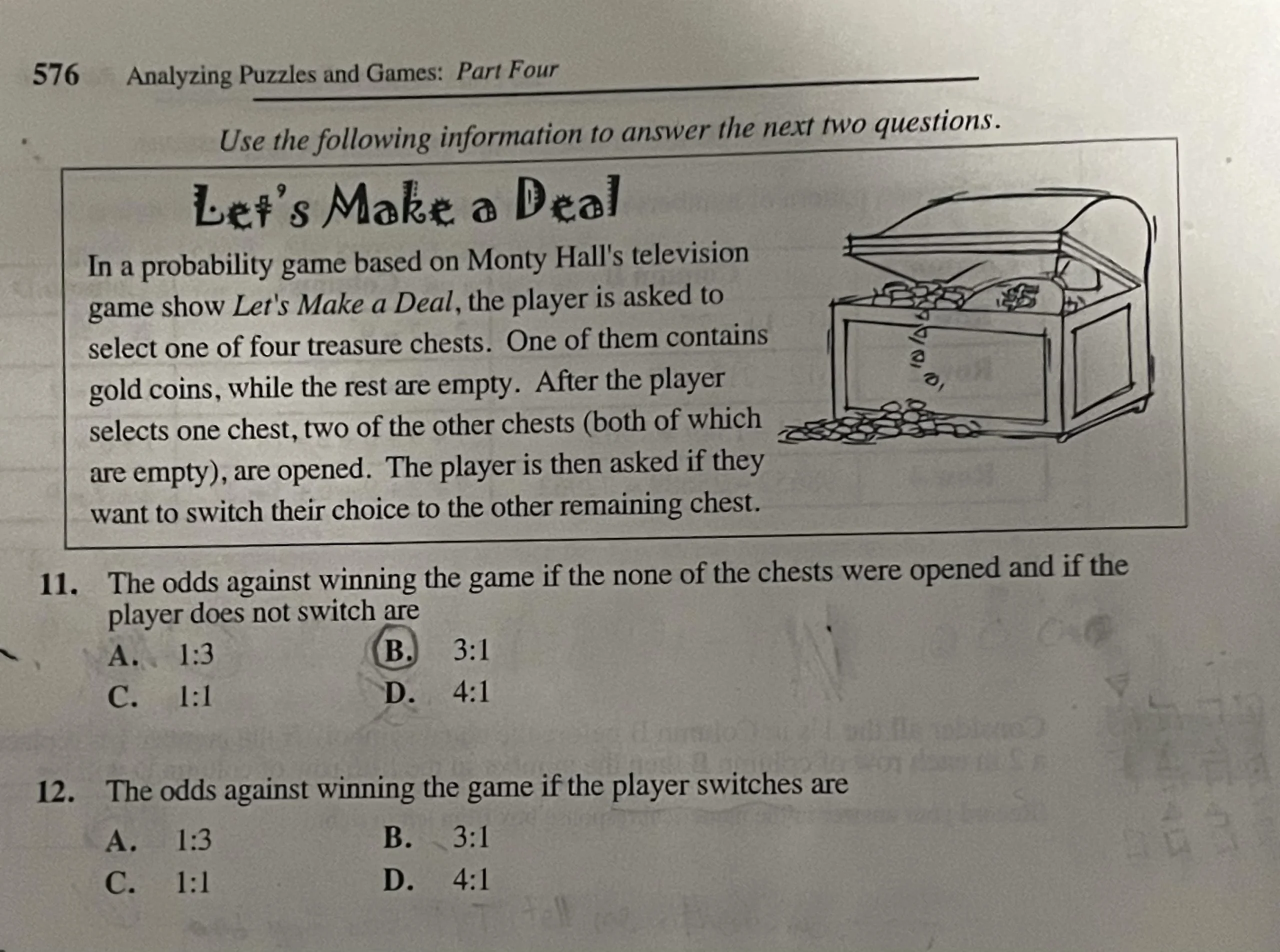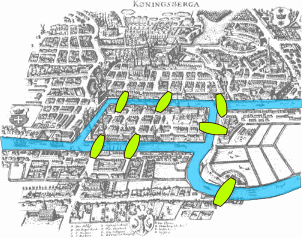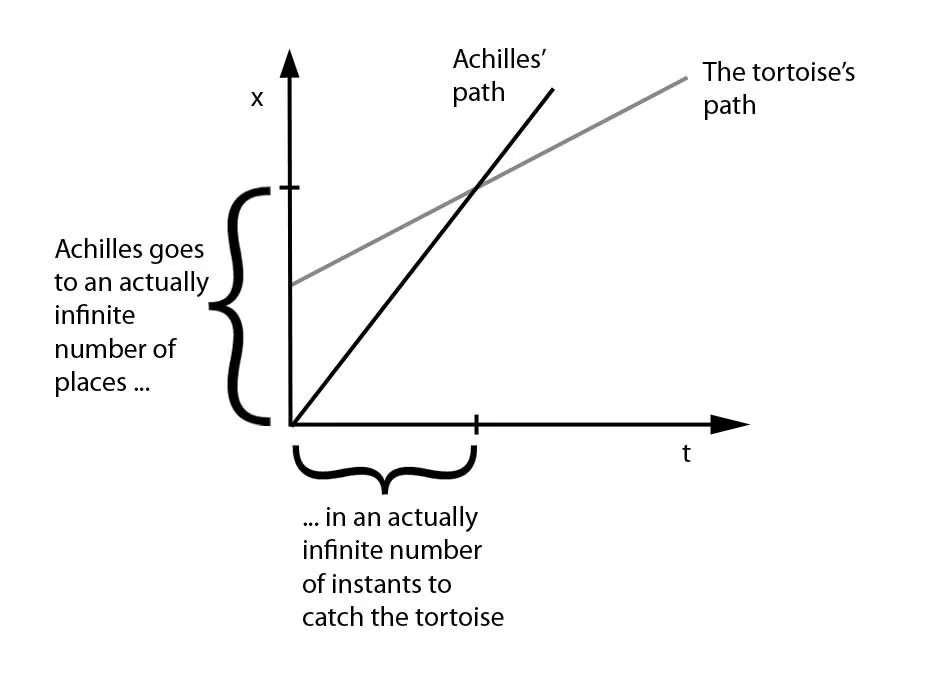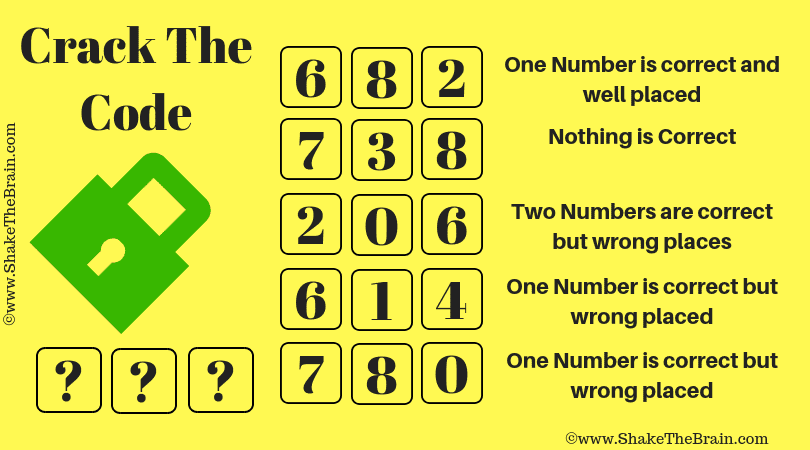Pose the classic brain teaser: 3 doors, 1 car. Should you switch your choice?
The Intuitive (and Wrong) Answer: Why Our Gut Feeling is to Stick with Our First Pick
The Monty Hall problem is one of the most counterintuitive puzzles in probability theory, challenging our instincts about chance and decision-making. Named after the host of the television game show “Let’s Make a Deal,” the problem presents a scenario that seems simple but reveals deep insights about how we process probability and make decisions under uncertainty.
Here’s the classic setup: You’re a contestant on a game show facing three closed doors. Behind one door is a car (the prize you want), and behind the other two doors are goats (consolation prizes). You choose one door, but it remains closed. The host, who knows what’s behind each door, then opens one of the remaining doors to reveal a goat. You’re then given a choice: stick with your original selection or switch to the other unopened door. What should you do?
Most people’s immediate intuition is that it doesn’t matter whether you switch or stay—the probability of winning is 50% either way. After all, there are two doors left, and one has the car. This seems like a simple case of equally likely outcomes. However, this intuitive answer is mathematically incorrect, and the real probabilities are quite different.
The persistence of this incorrect intuition reveals something important about human psychology and mathematical thinking. Our brains are wired to look for simple patterns and equal probabilities when the situation appears symmetrical. When we see two doors, we naturally assume each has an equal chance of hiding the prize. This cognitive bias, known as the equiprobability bias, leads us astray in the Monty Hall problem.
The mathematical error in this intuitive reasoning lies in failing to account for the host’s knowledge and behavior. When you initially choose a door, there’s a 1/3 chance you’ve selected the car and a 2/3 chance you’ve selected a goat. The host’s action of revealing a goat doesn’t change these initial probabilities—it’s constrained by them. If you initially chose a goat (which happens 2/3 of the time), the host must reveal the other goat, leaving the car as the only option behind the remaining door.
Psychological studies have shown that even when people are told the correct answer, they often struggle to accept it. This resistance to counterintuitive mathematical results is known as the Einstellung effect—our tendency to stick with familiar solutions even when better ones are available. The Monty Hall problem becomes a test of intellectual humility and willingness to revise beliefs in the face of mathematical evidence.
The intuitive 50-50 reasoning also fails to consider the information gained from the host’s action. In probability theory, when new information becomes available, we should update our beliefs using Bayesian reasoning. The host’s revelation of a goat provides valuable information that changes the probability structure of the problem, but our intuition treats it as irrelevant.
Cultural factors may also contribute to the persistence of the incorrect intuition. In many societies, there’s a saying “stick with your first choice” or “don’t change your mind,” which may influence our thinking about the Monty Hall problem. This cultural bias toward consistency can override mathematical reasoning, even when consistency isn’t the optimal strategy.
The problem also illustrates the difference between mathematical probability and subjective belief. Mathematically, the probabilities can be calculated precisely, but our subjective assessment of the situation may differ. This disconnect between objective mathematical truth and subjective perception is at the heart of many probability paradoxes and highlights the importance of rigorous mathematical analysis.
Even professional mathematicians initially struggled with the Monty Hall problem when it was popularized by Marilyn vos Savant in her Parade magazine column in 1990. Thousands of readers, including many with PhDs in mathematics, wrote to dispute her correct solution. This reaction demonstrates that counterintuitive mathematical results can challenge experts as well as novices.
The intuitive appeal of the 50-50 answer also relates to how we learn probability. Most introductory probability education focuses on simple, symmetrical cases where outcomes are equally likely. The Monty Hall problem breaks these patterns, requiring more sophisticated reasoning about conditional probability and the impact of new information.
Understanding why our intuition fails in the Monty Hall problem is valuable for developing better decision-making skills. It teaches us to question our assumptions, consider all available information, and recognize when our cognitive biases might be leading us astray. These skills extend far beyond game shows to important real-world decisions involving risk and uncertainty.
The mathematical lesson is that intuition, while often helpful, can be misleading in probability problems. Developing facility with formal probability methods—like tree diagrams, conditional probability, and Bayesian updating—provides more reliable tools for analyzing uncertain situations. The Monty Hall problem serves as a memorable example of why these mathematical tools are necessary.
The Mathematical Proof: A Simple Explanation of Why Switching Doubles Your Chances of Winning
To understand why switching doors in the Monty Hall problem doubles your chances of winning, we need to analyze the problem systematically using the tools of probability theory. The key insight is that the host’s action of revealing a goat provides valuable information that changes the probability structure of the game. Let’s work through the mathematical proof step by step.
We start with the initial choice. When you first select a door, there’s a 1/3 probability that you’ve chosen the car and a 2/3 probability that you’ve chosen a goat. These probabilities are determined purely by the random placement of the prizes and don’t change throughout the game. This is a crucial point that our intuition often misses.
Let’s consider what happens in each case. First, suppose you initially chose the car (probability 1/3). In this scenario, the host can open either of the two remaining doors, both of which hide goats. If you stick with your original choice, you win the car. If you switch, you lose and get a goat. So when you initially chose correctly, switching is the wrong strategy.
Now suppose you initially chose a goat (probability 2/3). Since there are two goats and you’ve chosen one, the other goat is behind one of the remaining doors, and the car is behind the third door. The host must open the door with the other goat—he has no choice, because he knows where the prizes are and must reveal a goat. This leaves the door with the car as the only remaining option. If you stick with your original choice, you get a goat. If you switch, you win the car.
Putting this together mathematically: If you never switch, you win only when you initially chose the car, which happens with probability 1/3. If you always switch, you win whenever you initially chose a goat, which happens with probability 2/3. Therefore, switching doubles your chances of winning from 1/3 to 2/3.
We can also analyze this using conditional probability. Let S be the event that you switch, W be the event that you win, and C be the event that you initially chose the car. We want to find P(W|S), the probability of winning given that you switch. Using the law of total probability:
Where C’ is the complement of C (initially choosing a goat). We know that P(W|S,C) = 0 (switching loses when you initially chose the car), P(W|S,C’) = 1 (switching wins when you initially chose a goat), P(C) = 1/3, and P(C’) = 2/3. Therefore:
A tree diagram can make this even clearer. At the first level, we branch based on your initial choice: car (probability 1/3) or goat (probability 2/3). At the second level, we consider the host’s action, which is deterministic given your choice. Finally, we consider whether you switch or stay. The tree shows that 2/3 of the paths lead to winning if you switch, while only 1/3 lead to winning if you stay.
We can also think of this in terms of information theory. Initially, you have 1 bit of information (which door you chose) but no information about where the car is among the three possibilities. The host’s revelation provides additional information, reducing the uncertainty. When you switch, you’re effectively using this new information to update your choice.
Bayes’ theorem provides another perspective. Let D₁, D₂, D₃ represent the events that the car is behind doors 1, 2, and 3 respectively. Suppose you choose door 1, and the host opens door 3 to reveal a goat. We want to find P(D₂|H), where H represents the host’s action. Using Bayes’ theorem:
We know P(D₂) = 1/3. If the car is behind door 2, the host must open door 3 (since he can’t open your chosen door 1 or the door with the car 2), so P(H|D₂) = 1. To find P(H), we consider all possibilities: P(H) = P(H|D₁)×P(D₁) + P(H|D₂)×P(D₂) + P(H|D₃)×P(D₃). If the car is behind door 1 (your choice), the host can open either door 2 or 3, so P(H|D₁) = 1/2. If the car is behind door 3, the host can’t open it, so P(H|D₃) = 0. Therefore:
So P(D₂|H) = (1×1/3)/(1/2) = 2/3, confirming that switching gives you a 2/3 probability of winning.
The mathematical proof also extends to variations of the problem. If there are n doors instead of 3, and the host opens n-2 doors to reveal goats, switching increases your probability of winning from 1/n to (n-1)/n. As n increases, the advantage of switching becomes even more dramatic.
Simulations confirm the mathematical analysis. Computer programs that play the Monty Hall game thousands of times show that switching wins approximately 2/3 of the time, while staying wins approximately 1/3 of the time. This experimental verification complements the theoretical proof and helps overcome intuitive resistance to the correct answer.
Understanding this mathematical proof provides insight into conditional probability, Bayesian reasoning, and decision-making under uncertainty. These concepts are fundamental to statistics, machine learning, economics, and many other fields. The Monty Hall problem serves as an accessible introduction to these important mathematical ideas.
Let’s Simulate It: Running Through the Scenarios to Make the Answer Crystal Clear
Sometimes the best way to understand a probability problem is to work through concrete examples. Let’s simulate the Monty Hall problem by considering all possible scenarios. Since the problem is symmetrical with respect to door labeling, we can assume without loss of generality that the car is behind Door 1. This simplification doesn’t change the mathematical probabilities but makes the analysis more manageable.
In our simulation, we’ll consider all possible combinations of your initial choice and the host’s subsequent action, then determine the outcome for both switching and staying strategies. Since there are 3 doors and you make 1 choice, there are 3 possible initial scenarios to consider.
Scenario 1: You initially choose Door 1 (where the car is)
Probability: 1/3
In this case, you’ve correctly identified the car. The host must now open either Door 2 or Door 3, both of which hide goats. Suppose he opens Door 3. The remaining doors are:
- Door 1: Your initial choice (car)
- Door 2: Unopened (goat)
- Door 3: Opened by host (goat)
If you STAY with Door 1, you WIN the car.
If you SWITCH to Door 2, you GET a goat.
Outcome: Staying wins, switching loses.
Scenario 2: You initially choose Door 2 (where there’s a goat)
Probability: 1/3
In this case, you’ve chosen a goat. The host knows the car is behind Door 1 and that Door 2 (your choice) has a goat. He must open the remaining door with a goat, which is Door 3. The remaining doors are:
- Door 1: Unopened (car)
- Door 2: Your initial choice (goat)
- Door 3: Opened by host (goat)
If you STAY with Door 2, you GET a goat.
If you SWITCH to Door 1, you WIN the car.
Outcome: Staying loses, switching wins.
Scenario 3: You initially choose Door 3 (where there’s a goat)
Probability: 1/3
This scenario is symmetrical to Scenario 2. You’ve chosen a goat. The host knows the car is behind Door 1 and that Door 3 (your choice) has a goat. He must open the remaining door with a goat, which is Door 2. The remaining doors are:
- Door 1: Unopened (car)
- Door 2: Opened by host (goat)
- Door 3: Your initial choice (goat)
If you STAY with Door 3, you GET a goat.
If you SWITCH to Door 1, you WIN the car.
Outcome: Staying loses, switching wins.
Now let’s summarize the results across all scenarios:
When you ALWAYS STAY with your initial choice:
- Scenario 1 (probability 1/3): You win
- Scenario 2 (probability 1/3): You lose
- Scenario 3 (probability 1/3): You lose
Total probability of winning by staying: 1/3
When you ALWAYS SWITCH to the remaining door:
- Scenario 1 (probability 1/3): You lose
- Scenario 2 (probability 1/3): You win
- Scenario 3 (probability 1/3): You win
Total probability of winning by switching: 2/3
This simulation approach makes the mathematical result crystal clear. Out of the three equally likely scenarios, switching wins in two of them while staying wins in only one. The host’s action of revealing a goat doesn’t create new uncertainty—it eliminates uncertainty by providing information that benefits the switching strategy.
We can extend this simulation approach to understand why our intuition fails. Let’s consider what happens if we ignore the host’s knowledge and treat his action as random. Suppose the host randomly opens one of the two doors you didn’t choose, and if he reveals the car, the game ends. In this modified game, the probabilities would indeed be 50-50 between switching and staying. Our intuition is correct for this different game, which may explain why it’s so compelling.
However, in the actual Monty Hall problem, the host is constrained by the rules: he must open a door with a goat and cannot open your chosen door. This constraint is what provides the additional information that makes switching advantageous. The simulation shows that this constraint creates a systematic bias in favor of switching.
We can also simulate the problem with more doors to see how the advantage of switching changes. With 100 doors, you choose 1, and the host opens 98 doors to reveal goats. Would you stick with your 1/100 chance or switch to the remaining door, which now has a 99/100 probability of hiding the car? The simulation approach makes it clear why switching becomes even more advantageous as the number of doors increases.
Computer simulations of the Monty Hall problem confirm our analytical results. In thousands of simulated games, switching wins approximately 2/3 of the time while staying wins approximately 1/3 of the time. The law of large numbers ensures that as the number of simulations increases, the observed frequencies converge to the theoretical probabilities.
These simulations also reveal the importance of the host’s behavior. If the host sometimes opens the door with the car or doesn’t always offer the option to switch, the probabilities change. The mathematical analysis depends on the specific rules of the game, which is why it’s important to specify them precisely.
Simulation approaches like this are valuable tools for understanding probability problems. They make abstract mathematical concepts concrete and help overcome intuitive biases. By working through specific examples, we can build intuition for more general mathematical principles and develop better decision-making skills for uncertain situations.
Conclusion: A Lesson in How Probability Can Defy Our Expectations
The Monty Hall problem demonstrates how probability can challenge our intuitions and reveal the limitations of informal reasoning about uncertainty. Our natural tendency to see equal probabilities in symmetrical situations leads us astray when we fail to account for the information provided by the host’s constrained actions. The mathematical analysis shows that switching doors doubles the probability of winning from 1/3 to 2/3, a result that seems counterintuitive but is rigorously provable.
This puzzle teaches us several important lessons about mathematical thinking and decision-making. First, it shows the importance of formal probability methods over intuitive reasoning when dealing with uncertainty. Our cognitive biases, while often helpful in everyday situations, can mislead us in mathematical contexts. Second, it illustrates how new information—even information that seems irrelevant—can change the probability structure of a problem. The host’s revelation of a goat is not just entertainment; it’s valuable information that should influence our decisions.
The Monty Hall problem also demonstrates the value of systematic analysis and simulation in understanding complex situations. By working through concrete examples and considering all possible scenarios, we can overcome intuitive resistance to counterintuitive results. This approach is valuable not just for puzzles but for real-world decision-making in business, medicine, engineering, and other fields where uncertainty plays a role.
Perhaps most importantly, the problem illustrates how mathematical education should develop not just computational skills but also intellectual humility. When our intuition conflicts with mathematical analysis, we should be willing to revise our beliefs based on evidence. The resistance of many experts to the correct solution to the Monty Hall problem shows that this intellectual humility is challenging even for those with advanced mathematical training.
The enduring popularity of the Monty Hall problem reflects our fascination with puzzles that challenge our understanding of the world. It serves as a reminder that the universe can behave in ways that seem paradoxical but are actually governed by precise mathematical laws. By studying such problems, we develop better tools for understanding complexity and uncertainty, skills that are increasingly valuable in our data-driven world.



